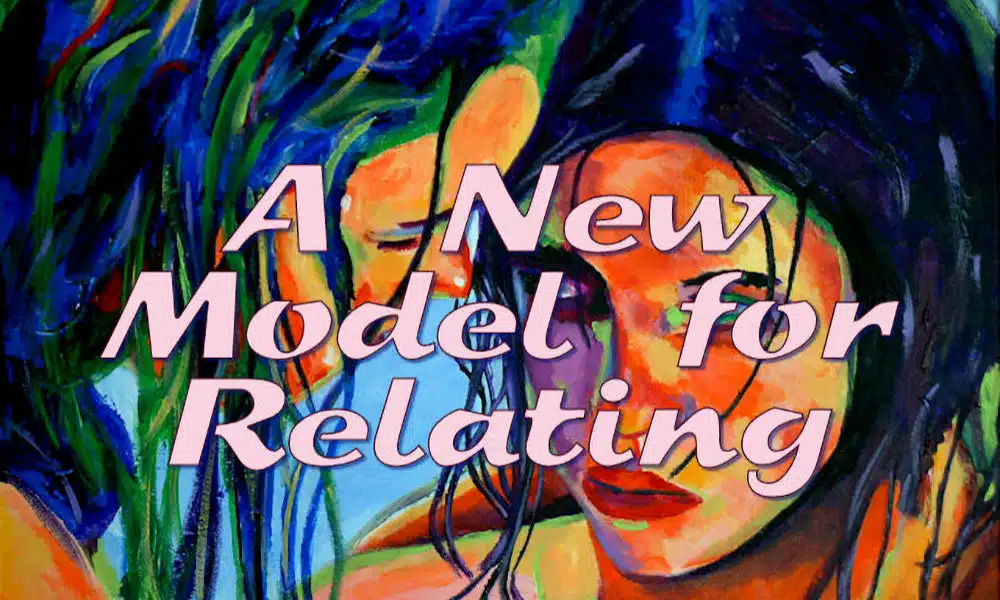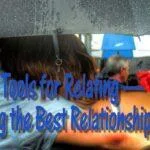A new model for relating — In order to have a better relationship, you have to change how you are doing things. You need a new model for relating. So, here it is!

Want to learn more about living a full and meaningful life?
Want to have the best relationship ever?
Check out my books

Note: If your present relationship needs work, well…
check out The. Best. Relationship. Ever.
It’s my relationships book… you’ll find all the help you need!
In order to have The. Best. Relationship. Ever., you must have a new model for relating. This requires rigorous self-exploration, and openness, honesty, and curiosity.
Mostly, because we’re lazy, we tend to repeat what doesn’t work. Or, we try out a technique for a bit, and when there’s a bump in the road, we pull out old, non-functional ways of relating.
We get stuck in a rut, and blame the rut
Failed relating follows a pattern — the same one Sam and Sally followed. There are not many variations on this theme — get into a primary relationship at a young age, flounder about, get lousy results, end the relationship, and then, do it again!
We do this in other areas of our lives as well — for example, in academic fields we don’t like. We don’t take the time to learn a new way — we just repeat what doesn’t work, and whine about our lousy results.
Here’s an example: I’m not so good at algebra. I got through it in High School and University, but never really figured it out. I did enough to pass. I memorized a few patterns, and studied old tests, and learned what I call “brute force” algebra. I have a few rules in my head, but absolutely no understanding.
Because I like to torture myself, when Darbella (who is great at math) taught algebra to her 8th grade Math students, I’d occasionally try one of the more complicated problems.
I’d just loop endlessly, trying to “simplify the equation.” Then I’d spend a bit of time moving things from one side of the = sign to the other.
I did what I always do with algebra problems. I guess, I try a few things I’ve tried before, and I hope that I will luck into an answer. Believe me, it is not a pretty sight.
Dar, on the other hand, just looks at the problem, applies logical and elegant steps, and solves it quickly. She can do this (and make it look simple!) because she ‘gets’ what underlies algebra.
Here’s how this applies to relationships
I don’t ‘get’ algebra, and I am unwilling to expend the effort to learn.
This is how most people deal with relating. They learn a few ‘rules’ in adolescence, typically from other ignorant people. Once they establish a pattern of behaviour, they apply the techniques out of blind habit and Ego, and think that, this time, they’ll get the ‘right’ answer.
They lack understanding, and may even be unaware how little they know about relating
Now, sometimes, rarely, this “brute force, unconscious” approach does work, giving one false hope. As I said, I passed algebra. I just never got good at it, or understood it. For me, to this day, algebra is a misery.
Acting from “unawareness” is limiting, disrespectful and leads back to the “I’m right and you need to see things my way.”
It’s a rule: if all I do is what I always do, plus cross my fingers, mostly, all I’ll get is lousy results. If I want to succeed, I must first deeply understand, and then apply, elegant solutions.
The crux of Elegant, Intimate Relating — a new model for relating
- The elegant part is this: an elegant relationship is both dynamic and flexible. There’s a flow — an ease. While there are different roles to explore, nothing is rigid, and everything is available.
- The intimate part is this: everything is out in the open, revealed, and honestly discussed. It is all about truthfulness, a relaxation of boundaries, and clear focus.
- Elegant, Intimate Relating is dynamic: while the methodology of relating stays the same, there is acceptance that “life” is constantly in flux. Emotions arise, and shift, and change. Roles shift, depending on the needs and desires of the partners. Nothing is graven in stone.
- Both partners are open and vulnerable: everything is accepted as real, and all feelings are fully felt and shared, without judgement, without trying to get your partner to behave some other way.
- Elegant, Intimate Relating is Respectful: it’s recognizing and celebrating the worth of your partner. It is impossible to respect someone for what he or she is going to do or be, someday, if all is well and “the creek don’t rise.” Respect is acknowledging the present worth of another person. Therefore, I can only “recognize and celebrate” someone right now.
- Elegant, Intimate Relating Requires Patience: it’s knowing that all I can do right now is what I can do right now. Patience is the ability to be present with things, situations, and people — while fully grasping that everyone and everything is in flux. “Things are as they are, until they aren’t.”
Everything is complete at every stage, while at the same time is moving with time toward a state of ‘more complete.’ This is a difficult concept.
Think about building a bridge. At every stage, each step — say, setting the pylons into the river — is ‘complete’ as it progresses. When they are digging the hole, that’s it — they are digging. Then, mixing concrete. Then, pouring concrete. Each step is, in its moment, a whole. In terms of each step’s ‘bridge-ness,’ it is also part of that process.
Thus, how it is right now is what to focus on — not how you wish it was, nor about how it used to be. Elegant, Intimate Relating is about living fully in the present moment.
Elegant, Intimate Relating is All about Intent
Elegant relating requires finding new ways of seeing and processing what is happening.
This is best accomplished by having a clue as to what I am trying to accomplish (my Intent,) all the time. Otherwise I will find that I am going off half-cocked.
So, if my goal is to relate with honesty and intimacy, any behaviour that does not facilitate this goal must be stopped as it emerges.
Example: Absolutist phrasing (“You are [always, never, every time, right wrong, etc.] doing…”) leads to fighting about whether the absolute is ‘true.’ It’s also limiting, disrespectful, and leads back to “I’m right and you need to see things my way.”
Once I know this, I can stop myself from making absolute statements, and say instead, “I’m noticing [whatever] and I wonder what’s going on for you.”
Good communicators will ask their partner, “What was your intent in asking me that?” It’s also a legitimate question for you to ask yourself. Just don’t stop too soon. Because intent is often not what you first think it is
Intent has to be expressed with total honesty. Hiding your intentions leads down a path we’d best avoid.
We’ll be fleshing out these concepts in the Tools Section, but I trust you’re getting an inkling about how different The. Best. Relationship. Ever. is from a ‘normal’ relationship. We’re going to continue to flesh out the concepts — next up — let’s talk about Dialogue.
The key to elegant relating is dialogue
Ongoing dialogue is a hard choice, and is selected by perhaps 5% of couples. Open, honest, vulnerable dialogue leads to a sense of aliveness, vibration and vibrancy, and energized living. Its characteristics are curiosity, passion, integrity, and co-creativity.
Wise souls take conflict personally
In other words, they examine themselves — to their personal participation — rather than placing blame. The wise soul looks at his behaviour — whatever isn’t working — and chooses to do something different.
Letting go of the need to be right is a vital part of elegant living, and essential for Elegant, Intimate Relating.
Understanding that differences are differences of opinion, not fact, is the mark of the beginning of maturity. Letting go of the need to be right allows me to become curious about who my partner is, and how he / she operates — differently than I do, yet never wrong.
A bit about fighting
“I never want to fight with my partner again!” is unreasonable. A fight, in a sense, is ending up on the other side of an issue you and your partner are passionate about. Passion is good!
Things go off the rails when either or both parties are neither aware nor present.
Here’s the story of all ‘bad’ fights
Person A notices something. It could be a “thing,” or behaviour. Let’s say it’s an unwashed coffee cup.
The coffee cup has no meaning — it’s neutral.
1st fork in the road:
Person A could say, “There’s an unwashed coffee cup. I’ll wash it.” No fight.
Or, Person A could say, “Geez, you forgot to wash the cup! You’re a lousy housekeeper, and besides, you do that to annoy me!” Hand grenade.
The first response is “what I am noticing.” The second response is: “I have a belief that my partner disrespects me, and this is another example.”
Person B now has the ball.
Person B might bite. “Up yours. I’m not the only one around here with hands, you know. Besides, I pick up for you all the time, and don’t bitch about it. I’m sick of your attitude.” Person B lobs the hand grenade back.
Or, Person B could say, “I notice you seem to be upsetting yourself, and I’m curious as to your intention.” Attempt to neutralize, and enter dialogue.
There is always a choice!
The rest of this book is about learning to pay attention to our process, how we upset ourselves, and how we talk. Fights start because both parties get caught up in proving the other person is either wrong, an ass, or both. Fights are short-circuited when one of the parties chooses to stop the drama, and becomes curious.
This is done through dialogue
We’re alive, I believe, to learn who we are — to expand and deepen our self-knowledge. We must do this in dialogue, because we are so good at self-justification — otherwise known as lying to ourselves. Without dialogue, we continue to make our crappy lives a misery — all the while focussing on what the other person (or the situation) is ‘doing’ to us.





